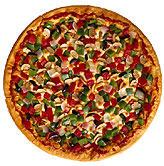More calories, fat, salt consumed on ‘pizza days;’ experts suggest pizza as target for intervention
MONDAY, Jan. 19, 2015 (HealthDay News) — On any given day in the United States in 2009 to 2010, one in five young children and nearly one in four teens ate pizza for a meal or snack, and when pizza is consumed, it makes up more than 20 percent of the daily intake of calories, according to findings reported online Jan. 19 in Pediatrics.
“Given that pizza remains a highly prevalent part of children’s diet, we need to make healthy pizza the norm,” study author Lisa Powell, Ph.D., a professor of health policy and administration at the University of Illinois at Chicago, told HealthDay. Powell’s team analyzed data from four U.S. National Health and Nutrition Examination Surveys from 2003 to 2010. Families of almost 13,890 children and teens, aged 2 to 19, reported what their children had eaten in the previous 24 hours.
From the first survey in 2003 to 2004 to the last survey in 2009 to 2010, calories consumed from pizza declined by one-quarter overall among children aged 2 to 11. Daily average calories from pizza also declined among teens, but slightly more teens reported eating pizza. The proportion of younger children eating pizza at dinner and from fast food dropped over the period studied. When they did eat it, however, it bumped up their total average calories eaten that day, especially if it was eaten as a snack or from a fast-food restaurant. On the days children ate pizza, they consumed 84 more calories, 3 grams more saturated fat, and 134 milligrams more sodium than average, the investigators found. Teens took in an extra 230 calories, 5 grams saturated fat, and 484 mg sodium on pizza days.
“There were no differences in impact on calories and nutrients between whether youths ate pizza from stores or from fast food, suggesting that efforts to improve the nutritional content of pizza should include pizza from all sources,” Powell said. The only time pizza did not increase children’s daily caloric intake were days they ate it from the school cafeteria. That could mean school pizzas are healthier, or it could mean other school lunches are equally high in calories, Powell said.
Copyright © 2015 HealthDay. All rights reserved.








